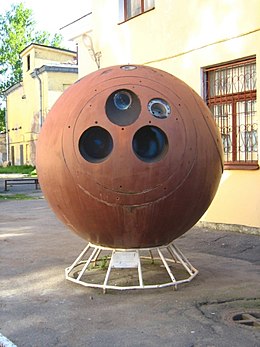Kosmos 18
 A Zenit reentry capsule | |
| Names | Zenit 2-11 |
|---|---|
| Mission type | Optical imaging reconnaissance Radiation |
| COSPAR ID | 1963-018A |
| SATCATno. | 586 |
| Mission duration | 9 days |
| Spacecraft properties | |
| Spacecraft type | Zenit-2 |
| Manufacturer | OKB-1 |
| Launch mass | 4730 kg[1] |
| Start of mission | |
| Launch date | 24 May 1963, 10:48:00 GMT[2] |
| Rocket | Vostok-2 |
| Launch site | Baikonur1/5 |
| Contractor | OKB-1 |
| End of mission | |
| Disposal | Recovered |
| Landing date | 2 June 1963 |
| Landing site | Steppe inKazakhstan |
| Orbital parameters | |
| Reference system | Geocentric[2] |
| Regime | Low Earth |
| Perigee altitude | 196 km |
| Apogee altitude | 288 km |
| Inclination | 65.0° |
| Period | 89.4 minutes |
| Epoch | 24 May 1963 |
Zenit programme Zenit-2 | |
Kosmos 18(Russian:Космос 18meaningCosmos 18) orZenit-2 No.11was aSovietoptical film-returnreconnaissance satellitelaunched in 1963. AZenit-2satellite, Kosmos 18 was the eleventh of eighty-one such spacecraft to be launched.[3][4]
Spacecraft
[edit]Kosmos 18 was aZenit-2satellite, a first generation, low resolution, reconnaissance satellite derived from theVostok spacecraftused forcrewedflights, the satellites were developed by OKB-1. In addition to reconnaissance, it was also used for research intoradiationin support of theVostok programme.It had a mass of 4,730 kilograms (10,430 lb).[1]
Launch
[edit]TheVostok-2rocket, serial number E15000-12,[5]was used to launch Kosmos 18. The launch took place at 10:48:00GMTon 24 May 1963, usingSite 1/5at theBaikonur Cosmodrome.[1]Following its successful arrival in orbit the spacecraft received itsKosmosdesignation, along with theInternational Designator1963-018A and theSatellite Catalog Number00586.[1]
Mission
[edit]Kosmos 18 was operated in alow Earth orbit.On 24 May 1963, it had aperigeeof 196 kilometres (122 mi), anapogeeof 288 kilometres (179 mi), with aninclinationof 65.0°, and anorbital periodof 89.4 minutes.[2]Having spent nine days in orbit, the spacecraft was deorbited on 2 June 1963. Its return capsule descended under parachute and was recovered by the Soviet forces in the steppe in Kazakhstan.[4]In addition to its imaging mission, Kosmos 18 was used to conduct measurements ofradiationlevels in low Earth orbit.[1]
See also
[edit]References
[edit]- ^abcde"Cosmos 18: Display 1963-018A".nssdc.gsfc.nasa.gov.NASA. 27 February 2020.Retrieved26 April2020.
 This article incorporates text from this source, which is in thepublic domain.
This article incorporates text from this source, which is in thepublic domain.
- ^abc"Cosmos 18: Trajectory 1963-018A".nssdc.gsfc.nasa.gov.NASA. 27 February 2020.Retrieved26 April2020.
 This article incorporates text from this source, which is in thepublic domain.
This article incorporates text from this source, which is in thepublic domain.
- ^Krebs, Gunter."Zenit-2 (11F61)".Gunter's Space Page.Archived fromthe originalon 31 December 2011.Retrieved14 December2013.
- ^abWade, Mark."Zenit-2".Encyclopedia Astronautica.Archived fromthe originalon 23 May 2012.Retrieved14 December2013.
- ^Wade, Mark."Vostok 8A92".Encyclopedia Astronautica.Archived fromthe originalon 22 August 2016.Retrieved13 December2013.
